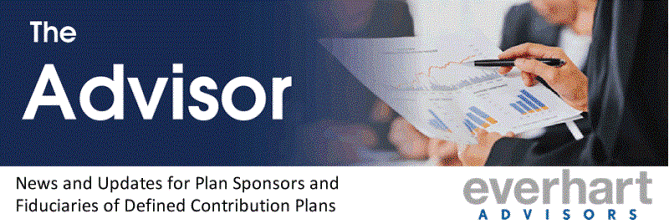 See below for the May 2015 edition of our E-newsletter, The Advisor
See below for the May 2015 edition of our E-newsletter, The Advisor
But He’s My Brother-in-Law!
As a plan sponsor and fiduciary, it may be tempting to use your brother-in-law, old college roommate or golf buddy as your company’s retirement advisor. After all, you know them well and they would never steer you in the wrong direction, right? However, ERISA’s rules are crystal clear: every decision you make as a fiduciary must be in the best interests of plan participants and their beneficiaries and certain relationships may result in prohibited transactions.
Your personal or corporate relationship with your company’s retirement plan advisor may create a conflict of interest. Be especially cautious when your personal financial advisor solicits your company’s retirement business. The fact that he works with you on personal matters could be interpreted as being in conflict with his providing services to your company. And more importantly, such an engagement could result in your having involved the plan in a prohibited transaction. Is he making recommendations on your company’s retirement plan that are benefiting you on a personal level? If so, or if that is even a remote possibility, the engagement is likely a prohibited transaction needing correction, filings and potentially penalties.
If questioned with regard to your selection of your retirement plan advisor, ideally you should cite your advisor’s expertise, independence, proven track record and the process you undertook in selecting the advisor. You do not want to be perceived as having chosen your retirement advisor because of a personal relationship.
Active Managers Can Add Value
There has been much publicity about active managers’ inability to beat their benchmarks over the years. However, upon closer inspection, funds that have remained truly active have shown ability to add value above their benchmarks. A study conducted by Yale professors Martijn Cremers and Antti Petajisto set out to find variables that could help predict fund performance. One variable was active share, which measures a fund’s percentage of holdings that differs from the benchmark index. For example, an index fund has an active share of zero percent and an active fund with no benchmark overlap has an active share of 100 percent. They found that active share is predictive of excess returns. Their study showed that funds with the highest active share and moderate tracking error outperformed by about 1.5 percent per year on average while funds with the lowest active share underperformed by a similar amount.¹
The mutual fund industry has evolved over the last 35 years, from an environment where most fund managers had portfolios significantly different than their benchmarks, compared to today where many have high benchmark overlap. In 1980 only 1.5% of fund assets had active share below 60% compared to 40% of fund assets at the end of 2009. Additionally, share of mutual fund assets in very active funds (80-100% active share) decreased from 60% to less than 20% over that same time period. Closet indexers (20-60% active share) now make up about a third of mutual fund assets.² A closet index fund is a particularly bad deal for investors as they will produce returns similar to the benchmark before fees and so are destined to underperform that benchmark by the amount of the fund’s fees. It is no coincidence that the cumulative excess returns of the median active fund peaked in the early 1980s and have steadily eroded with the proliferation of closet indexing.
The merit of active share is intuitive. If a fund is too similar to the benchmark it is trying to beat, the fund can’t generate enough excess returns to overcome fees charged to the investor. Furthermore, the key to outperforming over time is to consistently apply a well-defined process. If a manager has a well-defined process which seeks specific characteristics in a security, by definition it should produce a portfolio that is significantly different than the benchmark most of the time.
However, all active share is not created equal. Tracking error, which measures the variability of returns compared to the benchmark, is another important piece of the puzzle. Funds with very high tracking error tend to have large factor or sector bets that result in high volatility of returns compared to the benchmark. Cremers and Petajisto found that high active share managers that focused on stock selection within a diversified portfolio, while mitigating tracking error, had the best results. This group is represented by funds in the highest quintile of active share while excluding the highest quintile of tracking error. Funds with high active share and high tracking error and substantial factor bets were the worst performing sub group.³ In other words, managers who focus on stock selection as an alpha driver produced better results compared to managers that take large sector or factor bets.
Active share is just one factor to consider when selecting fund managers. Obviously, if a manager lacks skill and a sound investment process, high active share will only increase the risk fiduciaries are trying to minimize. Our Scorecard is in place to reduce this risk and help fiduciaries identify the skillful managers. Used in conjunction with high active share and moderate tracking error, the evidence suggests that active managers can add value.
This chart shows the percentage of assets in U.S. all-equity funds in each active share category over time.³
¹ http://papers.ssrn.com/sol3/papers.cfm?abstract_id=891719
² http://www.cfapubs.org/doi/abs/10.2469/faj.v69.n4.7
³ http://www.petajisto.net/research.html
Women: Financially Stressed but Open to Solutions
John Hancock Retirement Plan Services’ 2014 annual Financial Stress Survey¹ uncovered many interrelated stressors—including saving for retirement—in women’s lives. But it also shows great opportunity to help women prepare for retirement.
Women say they would be less worried about finances if they could save more and would spend time planning for retirement if they knew how to get started.
Women are more open than men to:
• getting a financial plan
• working with a financial advisor product
• using debt elimination tools
• purchasing a guaranteed income product
With help from financial advisors, plan sponsors, and retirement plan providers, women can learn how to reduce overall stress and prepare not only for retirement, but also for emergencies and big ticket items. Plan design features like auto enrollment and auto increase can make saving for retirement easy, while budgeting workshops, calculators, and tools can help them create and adhere to a financial plan.
¹ In May 2014, John Hancock Retirement Plan Services sponsored a research study to learn about peoples’ stress levels, the causes of their stress, and how to help them combat their stress. The study was conducted by respected research firm Greenwald and Associates, in talks with 1,500 current John Hancock Retirement plan participants.
This article was originally published by John Hancock Retirement Plan Services. Women: financially stressed but open to solutions. January 2015.
Socially Responsible Funds—Think Green? No. Think Red!
It was a few years ago that the Department of Labor issued guidance reaffirming their position that the goal for investments in ERISA plans (such as 401(k)s and 403(b)s) must be to design investment menus to allow participants to attempt to maximize returns and not for any factor other than the economic interest of the plan. The guidance specifically addressed funds meeting environmental (green) criteria known as socially conscience or socially responsible funds. “The plan’s fiduciaries may not simply consider investments solely in green companies. They must consider all investments that meet the plan’s prudent financial criteria.” This means that there should be no special consideration given to any investment due to its social agenda. The same selection and monitoring process that is utilized for the core investments in the plan’s menu must be applied to socially responsible funds. More from the DOL guidance, “…fiduciary consideration of noneconomic factors should be rare and, when considered, should be documented in a manner that demonstrates compliance with ERISA’s rigorous fiduciary standards.” Furthermore the DOL indicated that “fiduciaries who rely on factors outside the economic interests of the plan in making investment choices and subsequently find their decision challenged will rarely be able to demonstrate compliance with ERISA absent a written record demonstrating that a contemporaneous economic analysis showed that the investment alternatives were of equal value.” In other words, the fact that a fund is socially responsible is not a reason to offer it in a retirement plan. Always use quantitative and qualitative analysis to determine the appropriateness of investments in your plan.
Communication Corner: To Borrow or Not to Borrow?
This month’s employee memo discusses why taking a loan from the retirement plan can cause harm to a participant’s financial future.
Memo: To Borrow or Not to Borrow?
Email Marketing Software
powered by Cvent






